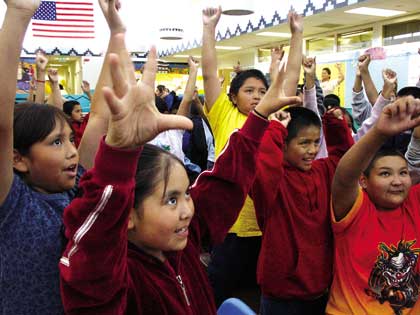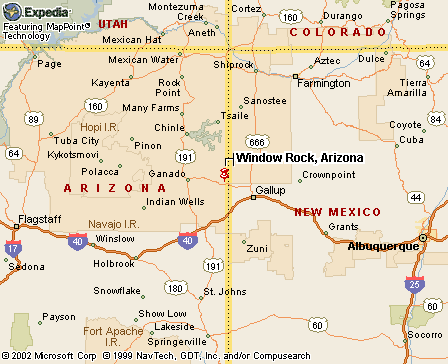|
|
Canku Ota |
|
|
(Many Paths) |
||
|
An Online Newsletter Celebrating Native America |
||
|
June 5, 2004 - Issue 114 |
||
|
|
||
|
Diabetes Can Be Contolled, Educator Says |
||
|
by Jan-Mikael Patterson - The Navajo Times |
||
|
credits: Students from Window Rock Elementary learn that physical activity should be part of a person's everyday routine during a presentation on diabetes May 13 at th school. (Times photo - Leigh T. Jimmie) |
|
That was the message Louise Querceto, health education technician with the Special Diabetes Project in Window Rock, delivered to students at Window Rock Elementary School on May 13. "It's not fun being a diabetic," Querceto said. "But I can control it." Querceto is a Type II diabetic meaning she has to take medication orally because her body has become resistant to insulin. Type I diabetics are people who cannot produce insulin to create energy for the body. Pregnant women who have high blood sugar but never had diabetes are said to have gestational diabetes. Diabetes is a disease where the body does not produce insulin, a hormone that helps convert sugar into energy. A lack of physical activity and being overweight or obese are contributing factors. The disease can cause blindness, heart disease, kidney failure and amputations. Querceto told the students that she lived away from the reservation eight years ago and she was physically active with her family. When she moved back to the reservation her physical activities slowly diminished and she became overweight within a year. Obesity and the lack of exercise exposed her to Type II diabetes. When she was told she was a diabetic Querceto did what most people do - denied it. "It was very hard," she said. "I didn't believe that I was diabetic but I had to face reality. I just didn't listen." Since coming to terms with her disease she has lost about 65 pounds and plans to lose more. "I'm still 55 pounds overweight," she said. Querceto has been diabetic for seven years. She said she did not listen to her mother and grandmother when they encouraged her to live and eat healthy. Querceto and Marlena Eriacho-Yazzie, a community health nurse with the Window Rock Diabetes project, presented the realities of the disease to the Window Rock Elementary students. At the beginning of the presentation she asked how many students had family members who are diabetic. About 25 students raised their hands. When they were asked of what causes diabetes, the students shouted "Grease, fry bread, mutton and junk food" from fast food restaurants. Eriacho-Yazzie used props during her presentation. When discussing the digestive process she showed students that food is sent to the pancreas in the body where it acts like a squeezed sponge that emits insulin. The insulin travels throughout the body through blood vessels and provides energy. "After you eat, what do you feel?" she asked the students. They responded, "Energy!" Insulin helps sugar flow freely through blood vessels but for a diabetic person, the blood sugar becomes syrupy and moves slowly. "You have to make choices," Eriacho-Yazzie said, as she encouraged students to live a healthy life. "The people at the all-you-can-eat places, they're not helping you any," Querceto said. "My mother died because of heart failure. I was told I was diabetic but I denied it. "Now I have to live with this," she said, holding back tears. She said once reality hit she made appropriate changes to her lifestyle. "It can be
done," Querceto said about battling and controlling diabetes. The Special Diabetes
Project was created in 1999 under the Navajo Nation Division of
Health. The project and the Indian Health Service combined efforts
by conducting public presentations and screening. Statistics compiled nationally by IHS show 110,305 Native Americans are diagnosed with diabetes. In 2003 there were 16,205 Navajos diagnosed as diabetic. Of those numbers 39 percent are male and 61 percent are female. Gina Milford, diabetes coordinator for the Fort Defiance hospital, said females go through gestational diabetes during pregnancy that can later expose them to Type II diabetes. Milford said 67 percent of diabetic Navajos are overt obese which is extremely overweight, and 38 percent are obese. She said 51 percent of diabetic Navajos are between the ages of 45 to 64 years old and 31 percent are over 65 years old. There are 20 different units located throughout the reservation and staff are continuously working with communities to reduce the rising number of diabetic patients. Rosemary Salabye, a health education technician at Sage Memorial Hospital in Ganado, conducted health screening for people who attended a song and dance at Greasewood Springs Community School on April 30. The community did their part to raise awareness of diabetes and offered the song and dance as a form of exercise. "There a lot of Type II patients," Salabye said about people who come to the hospital. "Type II is where people mostly take oral medication and are put on a diet. "Type I, they are people that are insulin dependent," she said. "Their blood sugar is not controlled that good so they have to have insulin shots. A lot of people have complications with it." About 750 people are registered with the diabetes program at Sage Memorial Hospital but most are Type II, Salabye said. |
|
|
www.expedia.com |
|
|
||
|
|
||
| Canku Ota is a free Newsletter celebrating Native America, its traditions and accomplishments . We do not provide subscriber or visitor names to anyone. Some articles presented in Canku Ota may contain copyright material. We have received appropriate permissions for republishing any articles. Material appearing here is distributed without profit or monetary gain to those who have expressed an interest. This is in accordance with Title 17 U.S.C. Section 107. | ||
|
Canku Ota is a copyright © 2000, 2001, 2002, 2003, 2004 of Vicki Barry and Paul Barry. |
||
 |
 |
|
|
The "Canku Ota - A Newsletter Celebrating Native America" web site and its design is the |
||
|
Copyright © 1999, 2000, 2001, 2002, 2003, 2004 of Paul C. Barry. |
||
|
All Rights Reserved. |
||
 WINDOW
ROCK - Diabetes is a serious disease but it can be controlled.
WINDOW
ROCK - Diabetes is a serious disease but it can be controlled.
